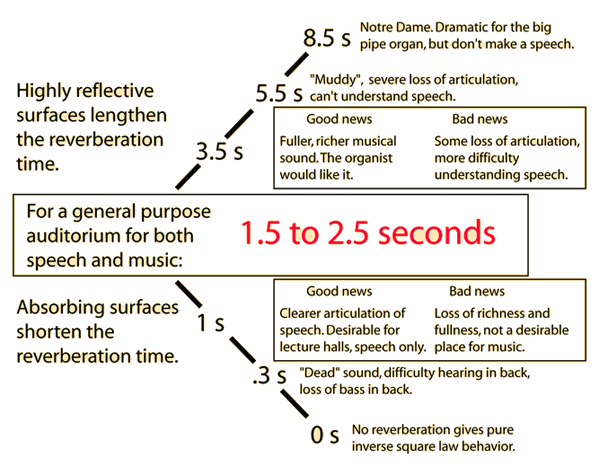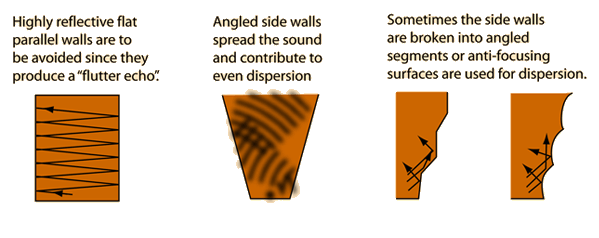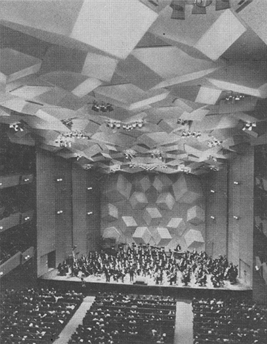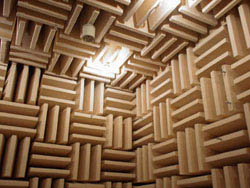ACOUSTICS IN ARCHITECTURE
While the science behind sound is well understood, using that science to create desired acoustical performance within a specific building or room is complex. There’s no single acoustical “solution” that can be universally applied to building design. However a theater is the sort of facility in which a satisfactory acoustic environment is integral to the building's success. Architectural acoustics is the process of managing how both airborne and impact sound is transmitted – and controlled – within a building design. While virtually every material within a room – from furniture to floor coverings to computer screens – affects sound levels to one degree or another, wall partitions, ceiling systems and floor/ceiling assemblies are the primary elements that designers use to control sound.
General Info
Although acoustic design has been around for a very long time (ancient greek theaters), there are a number of factors that we need to account for that historically simply did not exist. Acoustical services involve all kinds of spaces in and around buildings and are needed when clients are, or should be, concerned about the quality of sound throughout a completed building. Nowadays, we have a lot of background noise to account for from adjacent rooms, cars, and surrounding buildings. Way back in the old times, the only conflicting noise with that of a theater was probably the rustling trees and animals with a minimum urban background noise.
Type of sound source Maximum room volume (m3)
Average speaker 3000
Experienced speaker 6000
Instrumental or vocal soloist 10000
Large symphony orchestra 20000
Massed choirs 50000
When thinking of interior space acoustics, you must watch our for sound reflections. These sound reflections create standing waves that produce natural resonances that are rendered either pleasant to the ear or annoying. Straight surfaces are known to reflect sound back into a central space muddying up the sound clarity. Therefore, surfaces can be angled and coordinated to provide good coverage of sound for a listener in a concert hall or music recital space. Interior building surfaces can be constructed of many different materials and finishes. Ideal acoustical panels are those without a face or finish material that interferes with the acoustical infill or substrate. Fabric covered panels are one way to heighten acoustical absorption. Perforated metal and woos also show sound absorbing qualities. Below is an example of an interior surface that absorbs sound.
Clarity

Even Dispersion
Sound is more pleasing if it is evenly dispersed, with no prominent echoes, no significant "deadspots" or "live spots" in the auditorium. This even dispersion is usually achieved by avoiding any focusing surfaces and avoiding large flat areas which reflect sound into the listing area. Sometimes it is desirable to add some anti-focusing surfaces.
Minneapolis Orchestra Hall

There is an article about the opening of the Minneapolis Orchestra Hall published in Time magazine on November 4, 1974. The article gave this general description: "A capacity crowd of 2573 discovered that the new $10 million Orchestra Hall is a winner, with truly superior sound. The term for the way in which astage projects sound into an auditorium is 'throw'. Orchestra Hall has a throw that even Tom Seavermight envy. ... the new hall also has remarkable even dispersion of sound,... admirable balance and clarity, a striding bass and an exciting musical presence unsurpassed perhaps by any concert hall in the world. ..At times the volume of the orchestra approached the painful - clearly the result of the conductor's understandable desire to show off the hall's dynamic range."
Also....
Cool video in regards to designing with sound and noise in mind..
Sources:
http://hyperphysics.phy-astr.gsu.edu/hbase/acoustic/arcaco.html
http://fabricarchitecturemag.com/articles/052412_ce_hearingfabric.html
https://en.wikipedia.org/wiki/Architectural_acoustics
http://sensingarchitecture.com/649/7-design-tips-for-best-architectural-acoustics/http://www.aia.org/aiaucmp/groups/aia/documents/pdf/aiab089217.pdf
http://www.lencore.com/Portals/5/Lencore_Docs/Article_UnderstandingAcoustics.pdf
http://yaledailynews.com/blog/2012/10/08/the-acoustics-of-architecture/

No comments:
Post a Comment